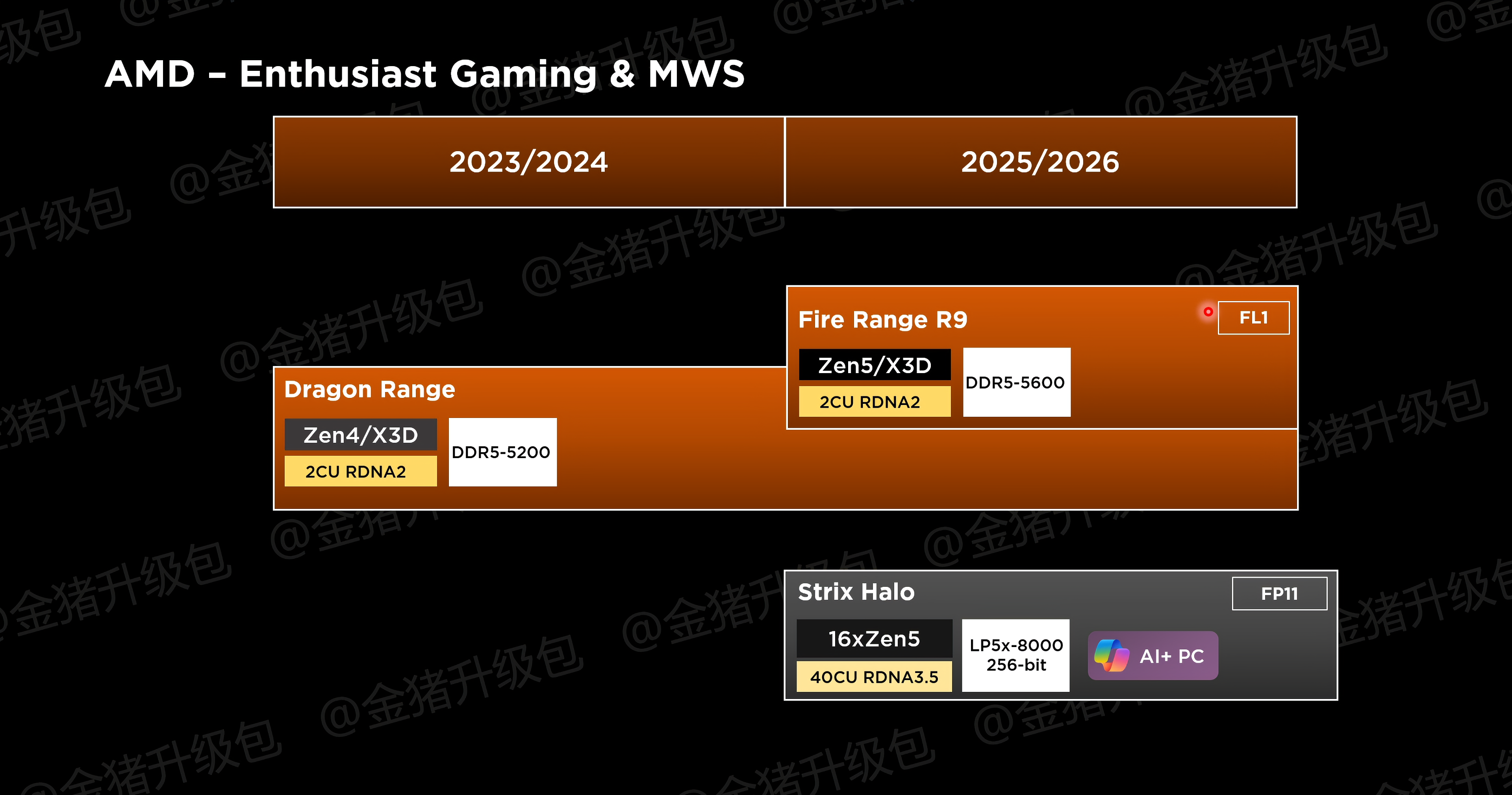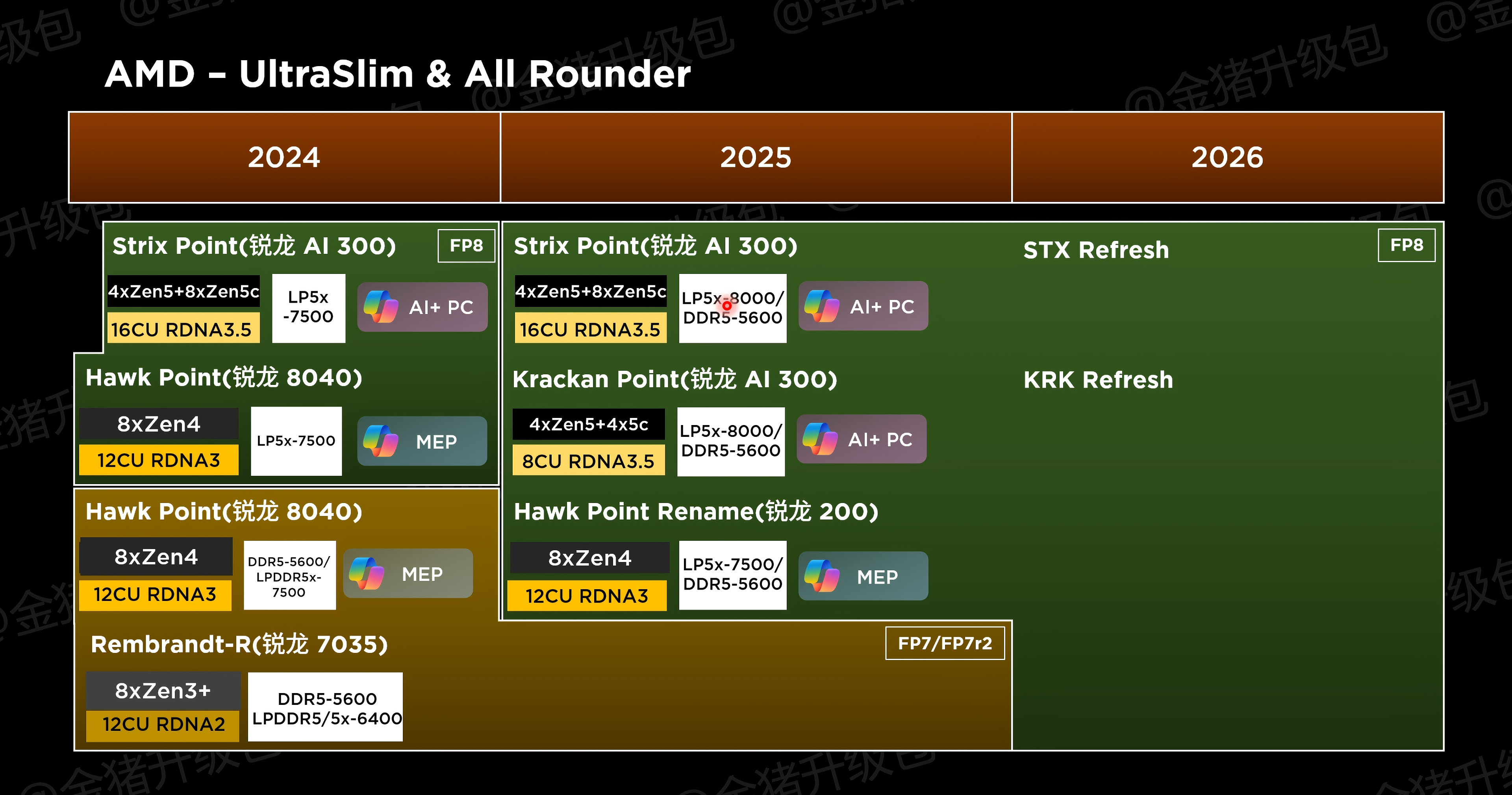AMD Strix Halo 'RDNA 3.5' iGPU rumored to launch under the Radeon 8000S branding — Up to 40 CUs and support for LPDDR5X-8000 memory
Not to be confused with the upcoming Radeon RX 8000 RDNA 4 lineup.

AMD's plans for the mainstream market have come to light as the company readies its upcoming Strix Halo, Fire Range, Krackan Point, and Radeon RX 8000 offerings thanks to a series of leaked roadmaps by Golden Pig Upgrade Pack on Weibo (via WCCFTech). Most notably, the flagship Strix Halo APUs will use the Radeon 8000S moniker for their integrated GPU (iGPU) solution - set to pack upwards of 40 Compute Units (CUs).
As per the leak, AMD's Strix Halo or Ryzen AI MAX 300 APUs will use the FP11 socket and host upwards of 16 cores (Ryzen AI MAX+ 395), based on the Zen 5 microarchitecture alongside a massive 40 RDNA 3.5 CU iGPU. In addition, Strix Halo offers support for 256-bit LPDDR5X-8000 memory with shipping manifests indicating up to (but not limited to) 128GB of RAM.
Going off on a tangent, the iGPU solution will fall under the Radeon 8000S umbrella; Radeon 8060S and Radeon 8050S. This is quite different from Rembrandt, Phoenix, and Strix - all of which used nearly identical Radeon 600M, 700M, and 800M conventions and might confuse some customers since the "S" suffix was seen on some Radeon 7000 dedicated laptop GPUs; the Radeon 7700S and Radeon 7600S.

The enthusiast laptop market is expected to soon welcome AMD's Fire Range series of CPUs. Based on Zen 5, Fire Range ups the memory support from DDR5-5200 to DDR5-5600 and will come in X3D flavors as well. Notably, Fire Range won't exactly succeed Dragon Range (Ryzen 7045HX) but will operate in parallel at least until 2026.

AMD is also working on enthusiast-grade RDNA 4 (Navi 4X) GPUs, widely slated to arrive sometime next year or in 2026. The budget end of the spectrum will continue with refreshes based on Navi 33 alongside Strix/Krackan APUs. What remains to be seen is whether AMD can deliver these GPUs in volume to OEMs, since we barely saw any laptops with dedicated Radeon 7000 graphics solutions.

Sticking to the consumer side of things, Strix Point will continue its journey into 2025 and will see a refresh (possibly like Hawk Point) in 2026. Krackan Point (Ryzen AI 300), likely to be announced at CES, will supersede Hawk Point (Ryzen 8040). AMD is also prepping a Ryzen AI 200 series - a refresh of Hawk Point, which itself is a refresh of Phoenix. Rembrandt-R (Ryzen 7035) isn't retiring anytime soon and will remain a staple in budget laptops by the end of 2025 - tying into AMD's plans regarding the Ryzen Z2 series.

All in all, AMD's portfolio for the next two years is jam-packed with exciting launches and plans. Please remember, the information shared in the leaked slides could contain errors — even if it comes from a usually reliable source and passes the sniff test. What also remains to be seen is the pricing and product availability. Strix Halo, Radeon RX 8000 desktop GPUs, and Krackan Point should be officially announced at CES 2025, but AMD may still have a few surprises up its sleeve.
Get Tom's Hardware's best news and in-depth reviews, straight to your inbox.

Hassam Nasir is a die-hard hardware enthusiast with years of experience as a tech editor and writer, focusing on detailed CPU comparisons and general hardware news. When he’s not working, you’ll find him bending tubes for his ever-evolving custom water-loop gaming rig or benchmarking the latest CPUs and GPUs just for fun.
-
Mama Changa Fire range is disappointing in not upping the CU count. Would have been nice for it to offer 6CU and NPU, but it suffers because it's the mobile version of the desktop parts.Reply
Fire range is pure Zen 5 cores, Halo is Zen 5 + Zen 5c BTW. -
Lucky_SLS Any idea on the TDP for the Ryzen AI 390/395? Seems like the perfect platform for the next gen consoles...Reply
Maybe with the RDNA 4 cores instead. -
DS426 Reply
Yeah, quite a monster with 40 RDNA 3.5 CUs and great being able to feed that with fast LPDDR5X. Unfortunately, the consoles probably won't use the full-fat dies, and certainly not on the CPU end; with consoles selling in the millions and cost being a key restriction, it'd only make sense to have down-binned parts, including cores that are turned off due to defects.Lucky_SLS said:Any idea on the TDP for the Ryzen AI 390/395? Seems like the perfect platform for the next gen consoles...
Maybe with the RDNA 4 cores instead.
The future of budget PC gaming really is with CPUs with strong iGPUs and no dGPU. -
renz496 Reply
Budget? Problem is this kind of APU did not cater budget market at all. Just look what happen with 5600G and 8700G. buget gamer can get better price/performance with standard CPU + discrete gpu.DS426 said:Yeah, quite a monster with 40 RDNA 3.5 CUs and great being able to feed that with fast LPDDR5X. Unfortunately, the consoles probably won't use the full-fat dies, and certainly not on the CPU end; with consoles selling in the millions and cost being a key restriction, it'd only make sense to have down-binned parts, including cores that are turned off due to defects.
The future of budget PC gaming really is with CPUs with strong iGPUs and no dGPU.